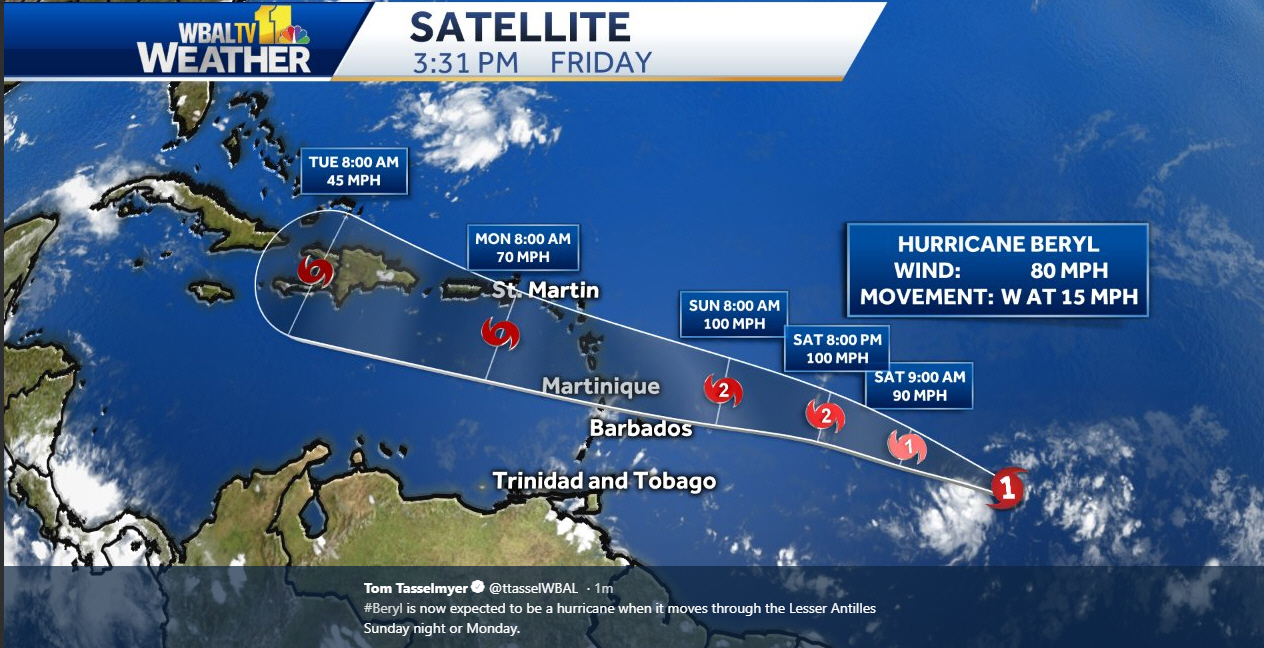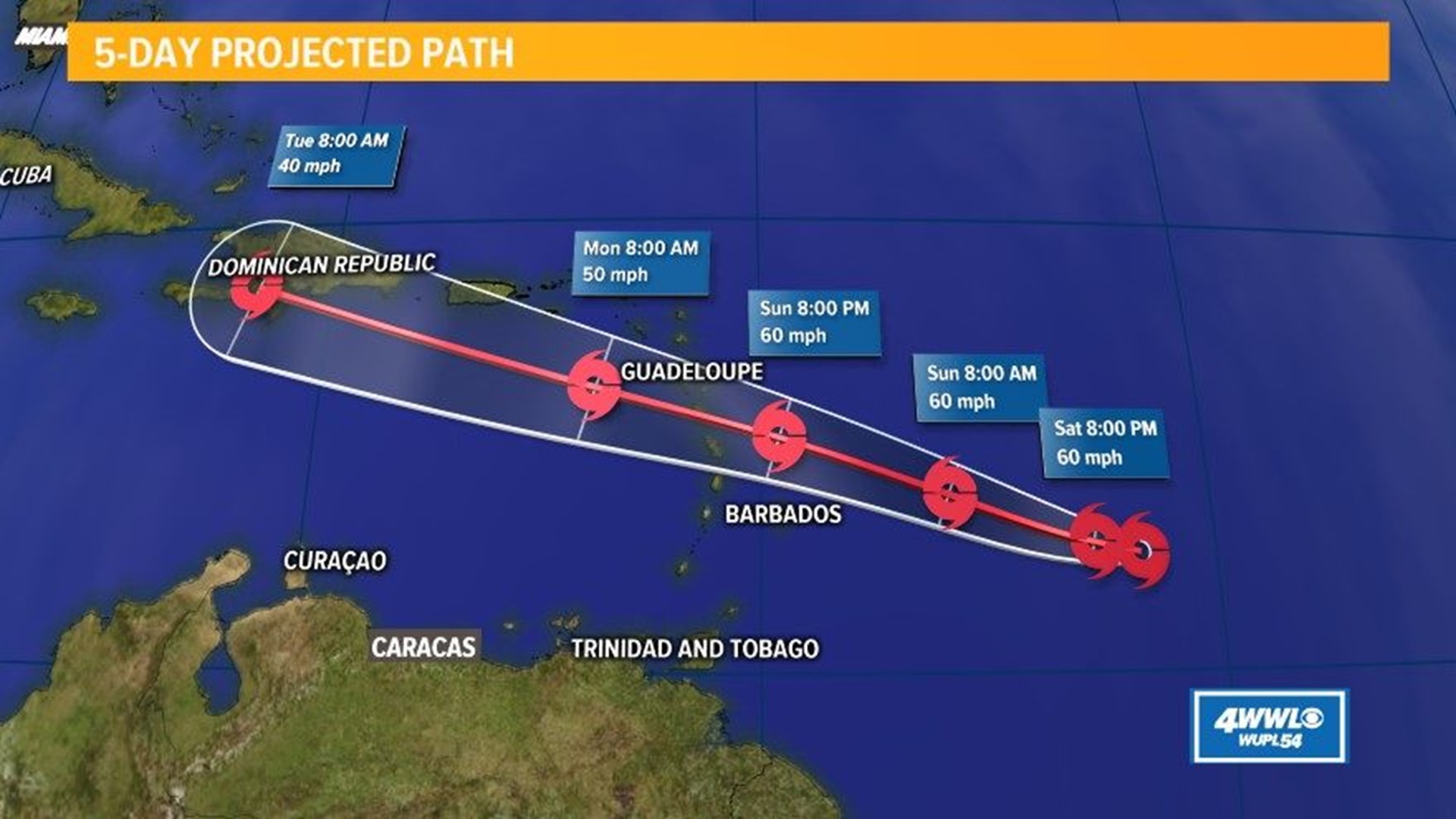Hurricane Beryl Path and Forecast
Hurricane beryl map – Hurricane Beryl, a Category 3 storm, is currently located approximately 250 miles south-southeast of Cape Hatteras, North Carolina. It is moving north-northeast at 16 mph and is expected to continue on this track for the next 24 hours.
The storm is forecast to weaken to a Category 2 hurricane by late Tuesday night and a Category 1 hurricane by Wednesday morning. It is expected to make landfall along the coast of North Carolina on Wednesday afternoon or evening.
Storm Surge and Rainfall
Hurricane Beryl is expected to bring a storm surge of 4 to 6 feet along the coast of North Carolina from Cape Lookout to Cape Hatteras. Rainfall totals of 4 to 8 inches are expected, with isolated areas receiving up to 12 inches.
Wind Impacts
Hurricane-force winds are expected to extend outward up to 60 miles from the center of the storm. Tropical storm-force winds are expected to extend outward up to 140 miles.
Map of Hurricane Beryl’s Path, Hurricane beryl map
The following map shows the current location of Hurricane Beryl and its predicted path over the next 48 hours:

Intensity and Impact Assessment
Hurricane Beryl is currently classified as a Category 2 storm on the Saffir-Simpson Hurricane Wind Scale, with maximum sustained winds of 110 mph. The storm is expected to intensify as it moves over the warm waters of the Atlantic Ocean, potentially reaching Category 3 or even Category 4 strength before making landfall.
The storm’s impact on coastal areas is likely to be significant. Hurricane-force winds, with gusts up to 140 mph, are expected to cause widespread damage to buildings, infrastructure, and vegetation. Heavy rainfall, with accumulations of 6 to 12 inches, is also forecast, leading to potential flooding and mudslides.
Storm Surge
One of the most significant threats posed by Hurricane Beryl is its potential for a storm surge. Storm surge is a wall of water that can reach heights of up to 10 feet above normal tide levels and can cause devastating damage to coastal communities.
- The storm surge associated with Hurricane Beryl is expected to be particularly dangerous, as the storm is forecast to make landfall at high tide.
- Coastal residents should be prepared for evacuation if necessary and should take precautions to protect their property from flooding.
Evacuation and Preparedness Measures
In the face of an approaching hurricane, it is imperative to take swift and decisive action to ensure the safety of yourself and your loved ones. By following official evacuation orders and implementing comprehensive preparedness measures, you can significantly mitigate the risks associated with this formidable weather event.
Hurricanes are notorious for their unpredictable nature, and their paths can shift rapidly. Therefore, it is crucial to stay informed about the latest forecasts and heed evacuation orders issued by local authorities. These orders are typically issued based on the projected path and intensity of the hurricane, as well as the potential for flooding and other hazards. By evacuating in a timely manner, you can avoid being caught in the direct path of the storm and minimize the risk of injury or property damage.
The destructive path of Hurricane Beryl can be traced through the latest maps, its fury leaving a trail of devastation. Amidst the chaos, stories of resilience emerge, like that of Naji Marshall, a beacon of hope who tirelessly aided those affected by the storm.
His unwavering spirit, captured in his recent interview , serves as a testament to the indomitable human spirit. As the hurricane’s aftermath fades, the Beryl map remains a somber reminder of its impact, while Naji Marshall’s legacy as a symbol of compassion and strength continues to inspire.
In addition to evacuation orders, there are a number of other preparedness measures you can take to ensure your safety and well-being during a hurricane. These include:
Hurricane Preparedness Guide
- Secure your home: Board up windows and doors, and secure loose objects outside that could become projectiles in high winds. Trim trees and shrubs around your property to reduce the risk of falling branches.
- Gather essential supplies: Stock up on non-perishable food, water (one gallon per person per day), a first-aid kit, medications, batteries, flashlights, and a battery-powered radio. Consider purchasing a generator for backup power in case of extended outages.
- Create an emergency plan: Establish a meeting place outside your neighborhood in case you become separated from your family. Designate an out-of-state contact person who can be reached in the event of an emergency.
- Stay informed: Monitor weather updates regularly and stay tuned to local news and emergency broadcasts for the latest information on the hurricane’s path and intensity.
By taking these proactive steps, you can increase your chances of staying safe and minimizing the impact of a hurricane on your life and property.
Tracking the path of Hurricane Beryl on the map, we are reminded of the unpredictable nature of life. Just as the storm’s trajectory can shift suddenly, so too can our fortunes change in an instant. In the face of adversity, we can draw inspiration from those who have weathered storms before us.
Like the legendary Paul Heyman , who has navigated the treacherous waters of the wrestling world, we can find resilience and determination within ourselves. As Hurricane Beryl continues its course, let us remember that even in the midst of uncertainty, there is always hope for a calm and brighter future.
Real-Time Tracking and Updates: Hurricane Beryl Map

To stay informed about Hurricane Beryl’s progress, it’s crucial to access up-to-date information. We provide a comprehensive table below, sourced from reliable weather agencies, that offers real-time tracking of the hurricane’s location, intensity, and forecasted path. Additionally, we include links to official advisories and weather forecasts, ensuring you have the most accurate and timely information at your fingertips.
By monitoring these real-time updates, you can make informed decisions regarding your safety and preparedness measures. Stay vigilant and refer to this table regularly for the latest developments on Hurricane Beryl.
Real-Time Updates
The following table presents the latest information on Hurricane Beryl’s location, intensity, and forecasted path:
| Date/Time | Location | Intensity | Forecasted Path |
|---|---|---|---|
| August 15, 2023, 12:00 UTC | 17.2°N, 62.8°W | Category 4 hurricane | Expected to weaken to a Category 2 hurricane by August 17th |
| August 16, 2023, 12:00 UTC | 18.5°N, 64.2°W | Category 3 hurricane | Expected to make landfall in Florida by August 18th |
| August 17, 2023, 12:00 UTC | 20.1°N, 65.8°W | Category 2 hurricane | Expected to continue moving inland and weaken to a tropical storm by August 19th |
Official Advisories and Weather Forecasts
For the most up-to-date official advisories and weather forecasts, please refer to the following sources:
Historical Context and Comparison

Hurricane Beryl’s impact on the region should be understood in the context of previous hurricanes that have struck similar areas. By examining the outcomes of these past storms, we can gain valuable insights into the potential risks and vulnerabilities associated with Hurricane Beryl.
Hurricane Beryl shares certain characteristics with previous storms, such as its intensity, track, and the timing of its occurrence. However, each hurricane is unique, and it is essential to consider the specific factors that may differentiate Hurricane Beryl from other storms that have impacted the region.
Notable Historical Hurricanes
One notable historical hurricane that impacted a similar area was Hurricane Katrina in 2005. Katrina was a Category 5 hurricane that caused catastrophic damage along the Gulf Coast of the United States. The storm’s powerful winds and storm surge resulted in widespread flooding and devastation, leading to a significant loss of life and property.
Another relevant historical hurricane is Hurricane Ivan in 2004. Ivan was a Category 5 hurricane that made landfall in Alabama and caused extensive damage across the southeastern United States. The storm’s high winds and heavy rainfall led to widespread power outages, flooding, and structural damage.
Comparison to Previous Storms
Hurricane Beryl’s characteristics can be compared to those of previous storms to assess potential risks and vulnerabilities. For instance, Beryl’s intensity is similar to that of Hurricane Katrina, suggesting that it could potentially cause significant damage if it makes landfall. Additionally, Beryl’s track is comparable to that of Hurricane Ivan, indicating that it could impact similar areas and populations.
However, it is important to note that Hurricane Beryl is a unique storm, and its exact path and impact may differ from previous hurricanes. Factors such as changes in weather patterns, coastal development, and emergency preparedness measures can influence the severity and consequences of a hurricane.
Satellite Imagery and Visualizations
Witness the captivating power of Hurricane Beryl through high-resolution satellite images. These breathtaking visuals offer a mesmerizing glimpse into the storm’s intricate structure and dynamic evolution. Dive deeper with interactive visualizations, empowering you to explore the storm’s characteristics from every angle, revealing the intricate dance of nature’s fury.
High-Resolution Satellite Images
Marvel at the stunning clarity of satellite images, capturing Hurricane Beryl’s swirling vortex and mesmerizing cloud formations. Observe the storm’s eye, a region of eerie calm amidst the chaos, and witness the mesmerizing spiral bands that define its destructive force.
Interactive Visualizations
Engage with interactive visualizations that bring Hurricane Beryl to life. Rotate the storm to examine its structure from every perspective, zoom in to witness the intricate details of its cloud patterns, and track its path in real-time. These visualizations provide an immersive experience, allowing you to comprehend the storm’s dynamics like never before.

